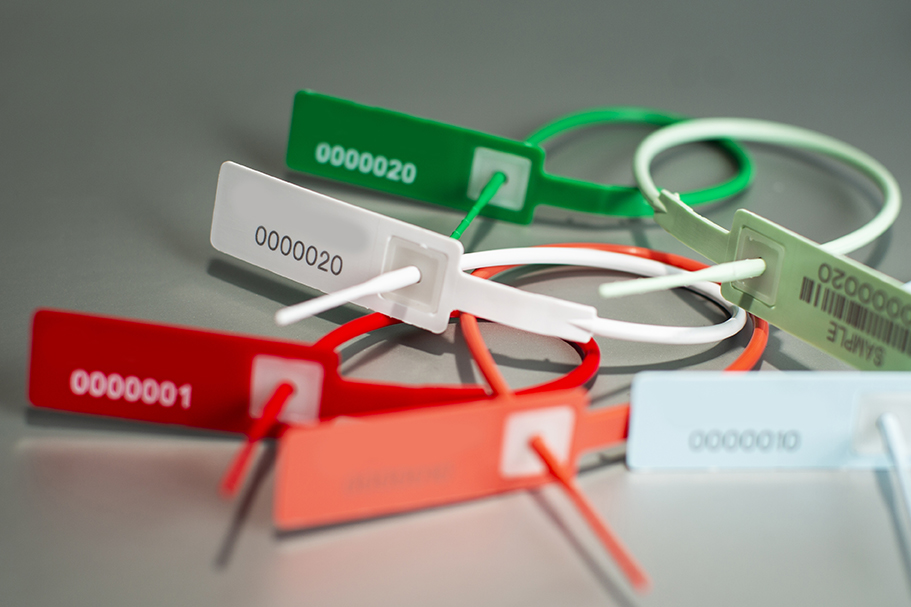Why security seals?
- Preventing opportunistic theft
- Making attempts at tampering visible
- Preventing contamination
- Preventing the trade in contraband
- Preventing the loading of weapons and explosives
The risk of theft and crime increases with the value of the goods being transported and so do the requirements for security seals. The following points influence our policy when designing high-quality security seals:
- Security seals should indicate whether a locking mechanism has already been opened previously
- Tamper security makes tampering practically impossible, difficult or at least time-consuming
- Adding tamper-proof functions to make unauthorized tampering with the security seal visible
- Resistance to part replacement
- Preventing accidental breaking of the seal
These requirements usually lead to the use of seals made from a wide variety of parts and materials. In combination with the customer logo, sequential numbering, barcode, data matrix codes, etc., this ensures that each seal is unique and cannot be replaced.
Levels & norms of security
A security seal is used to indicate tampering and as a preventative measure to prevent theft or unauthorized access. Security seals are generally classified as “indicative”, “security” or “high security” and are supplied in fixed or variable lengths depending on the application. Each security seal is supplied with a unique serial number as standard, which is recorded and therefore fully traceable.

Indicative seals are generally made of plastic (polyethylene, polypropylene, etc.) that has a relatively low breaking point and can be easily removed by hand or with scissors/cutting pliers. Indicative seals are therefore ideal for quickly discovering attempts at fraud and/or theft.

Security seals are made of plastic or metal with greater resistance. Simple tools are needed to remove this seal. This type of seal requires inspection to determine if attempts have been made to break the seal.

High Security seals have indicative properties but are made of metal or metal cable. The resistance slows down the removal of the seal. High Security seals cannot be removed manually; a concrete shear is required. High Security seals are ISO 17712 certified and meet the C-TPAT standards.

This designation means that the seal has been tested and meets a specific quality standard.

This standard is increasingly requested for seals for containers that are transported internationally. The seal must meet specific criteria.

The “Customs-Trade Partnership Against Terrorism” is the standard developed for high-quality seals, which are used for containers, entering the USA. The standard is equivalent to ISO 17712 and replaces the “UK Customs tested”.
Types of security seals
Plastic security seals
Plastic security seals are made from different types of plastic and are mainly used to demonstrate manipulation, fraud or theft. Thanks to the design of plastic security seals, it can be visually determined whether an attempt at manipulation has taken place. Because a broken plastic security seal can be an indication of manipulation, fraud or theft, it is also often called an indicative seal.
There are different categories of plastic security seals. They are mainly designed as adjustable length seals (also called variable length seals or pull seals), fixed length seals, padlock seals or insert seals. Depending on the application, the object to be sealed and the requirements for the security level, one type of plastic seal is better suited for a certain application than another. Typical applications include bags, trolleys for the aviation and catering sector, boxes, barrels, roll cages, etc.
Plastic security seals can usually be personalised with a customer logo. The uniqueness of the seal is guaranteed by a unique number and barcode.
With the different colours available for plastic security seals, not only is personalisation of the seal possible, but it is also easy to distinguish between the different logistical processes within a company.
Metal security seal
Seals with metal band / metal clip, made of a metal material, are usually used as barrier protection.
Bolt seals offer the highest barrier protection and are made of two metal parts that are designed to fit together via a locking mechanism.
Cable seals consist of a steel cable that is attached to the locking mechanism of the seal body at one end.
Reusable security seals
Reusable security seals consist of a reusable main part that is protected with a single-use seal.
Electronic seals
Electronic seals are usually reusable. A unique time, date and number are generated each time the seal is opened or closed. Record and document all seals and openings.
Indication labels
Indication labels are physically applied to a surface and allow the user to leave a residue, pull apart and/or leave evidence of attempted removal or tampering.




